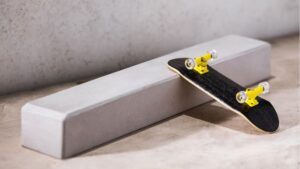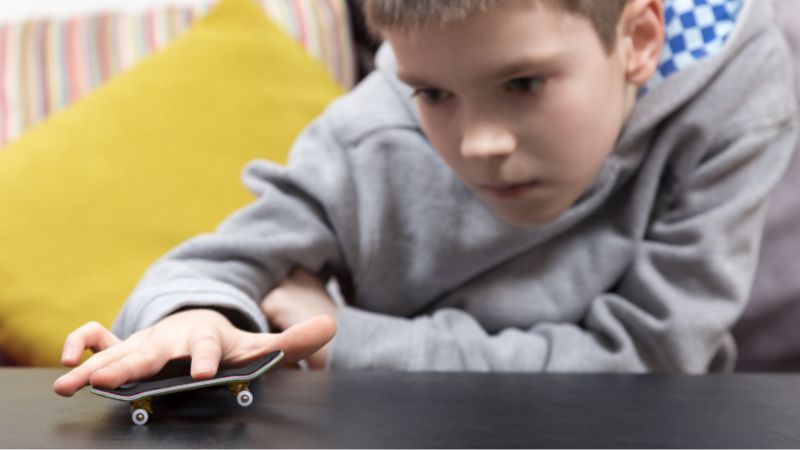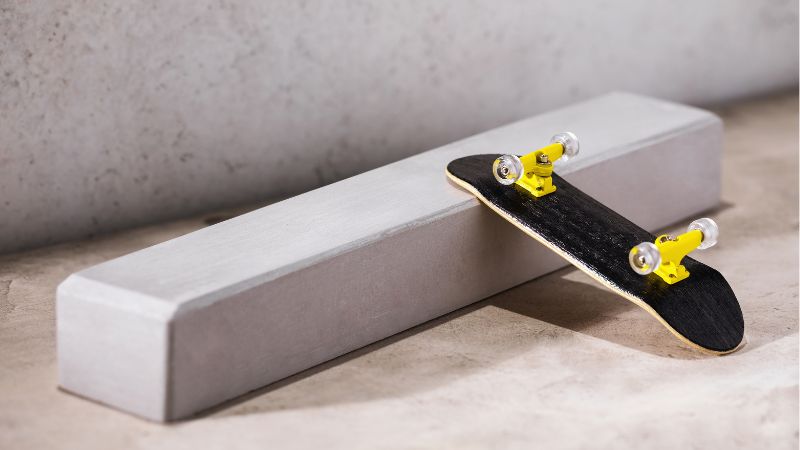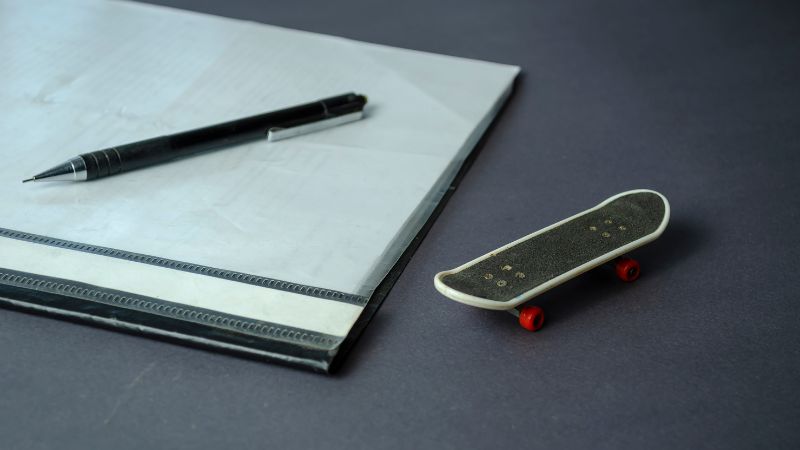
How to Make a Fingerboard Ramp? Easy Guide
Ever since I discovered fingerboarding, the scaled-down cousin of skateboarding, I’ve been hooked. There’s something truly mesmerizing about executing intricate tricks with just my fingers

Skateboarding and fingerboard tricks are always fun and worth learning. With so many tricks out there, it can be hard to choose which one to learn first, and that’s completely normal.
As skateboarders and fingerboard enthusiasts, we should aim to learn more than just one or two tricks. That’s why we’ve put together this list of fingerboard tricks for you. These will help you get better at using fingerboards.
In this list, we won’t just focus on learning tricks one by one. You’ll also discover that some skills you learn for one trick can be used in others too!
List of fingerboard tricks to try out
In this list of Tech Deck tricks, we’ll explore a variety of tricks. These will range from easy to more challenging, suitable for both beginners and advanced users. This approach will help us figure out which tricks to focus on first and come up with the best strategy to master them all. Remember, we’re using our right hand for these tricks.
In many tutorials for skateboard or fingerboard air tricks, you’ll find the ollie. It’s often the starting point for many tricks, and this is true for fingerboards as well.
You don’t need much space for this trick. Start by placing your index finger just behind the front truck bolts and your middle finger on the tail of the fingerboard.
To do the ollie, snap the tail of the board down while sliding your index finger towards the nose of the board. This action will lift the board into the air. Try to keep it level while it’s in the air. Then, land it back on its wheels.
Here is the video on how to ollie on a fingerboard:
There are variations of the ollie on a Tech Deck, which mainly differ in how much the board spins. Some of these include:
Kickflips are another essential trick that you should learn alongside ollies.
To successfully execute a kickflip, it’s not just about pressing the fingerboard down after popping it into the air like an ollie. Once the fingerboard lifts off following your snap, slide your index finger toward the nose pocket that’s closer to you.
Then, gently press it to make the deck spin along its length. While the board is in the air, use your index and middle finger to locate its stepping surface. Finally, guide the fingerboard to land back down.
In addition to the standard kickflip on a Tech Deck, there are variations you can try:
Shuvits are tricks you can do on a Tech Deck without needing to lift the board too high. This trick involves a simple switch from the nose to the tail position.
The aim here is to make the fingerboard rotate 180°. So, starting from an ollie position, pull the deck’s tail inward.
As you pull the tail of the deck, lift your hand slightly. This movement will cause the nose of the board to spin. When the board completes its 180° turn, stop its spin by placing your fingers back on it.
There are also variations of the shove-it or shuvit, including:
Nollies are fingerboard tricks that are essentially the opposite of an ollie, and they’re great for fans of ollie tricks.
To start a nollie, place your index finger on the nose of the fingerboard and your middle finger just in front of the rear truck bolts.
To perform the nollie, move your skateboard forward in the direction of the nose. As it starts to gain speed, use your index finger to pop the fingerboard, snapping the deck’s nose.
You might find it a bit awkward initially to shift the deck’s tail upwards with your wrist.
Once the fingerboard completes about a 90° turn, press the tail down to level it with the nose. Finish by landing the board with both fingers.
Frontside Pop Shove are a thrilling yet achievable trick for beginners. This trick involves rotating the fingerboard 180° in the opposite direction of a regular shove-it, adding an extra layer of challenge.
Begin in your standard fingerboard position. Roll the board forward and then snap the tail as you would for an ollie.
As the board begins to rise, use your back finger to gently push the tail towards the front of your body. This motion will cause the board to spin frontside (towards your chest).
The key is to control the spin so that the board completes a half-turn (180°). As the board finishes its rotation, catch it with your fingers and guide it back down to land on its wheels.
This trick not only builds on the basic ollie and shove-it mechanics but also adds a new dimension to your fingerboard skills.
You might have noticed that the first five tricks we talked about are all linked to the ollie and are fundamental in the world of skateboarding tricks. This is why mastering the ollie is a crucial skill for both fingerboarding and skateboarding.
Next, let’s dive into some more challenging fingerboard tricks that are sure to make you work a bit harder.
The heelflip is essentially the opposite of a kickflip. In this trick, you’ll make the fingerboard spin away from you.
Start in the ollie position: place your index finger behind the front truck bolt and your middle finger on the tail. Push the fingerboard towards the direction of the nose and pop its tail.
As the board lifts off, press down on the part of the deck that’s farther away from you. This action will cause the board to turn.
Once the fingerboard completes its turn, use your fingers to find its stepping surface. Finish the trick by landing the board on its wheels.
Despite its name, the “Impossible” is definitely a trick you can learn. It’s challenging because it requires precise control of the fingerboard while it’s in the air. Here’s how to do it.
Start with your standard finger positioning. Roll the board forward and then snap the tail to launch the fingerboard into the air.
As soon as the finger skateboard lifts off, quickly pull your index finger back. This motion causes the deck’s nose to rise and spin towards the back.
The fingerboard will perform a 360° turn around its nose and tail axis. When it completes this rotation, place your index finger above the stepping surface. Land the board in the same way as you did with the previous tricks.
Other tricks derive from the Impossible, such as:
The hard flip may sound like a daunting trick, but it’s achievable with practice. It’s similar to a kickflip, but it also incorporates elements of a pop shuvit.
Begin in the standard fingerboard position. Push the board forward while snapping its tail.
As you would in a kickflip, move your index finger to the front pocket that’s closer to you. In this move, the fingerboard shifts as in a shuvit, and it also spins on its side like a kickflip.
After the board completes its spin and rotation, position your fingers above it and land the board on its wheels.
If you’re up for an even bigger challenge, you might want to try these more advanced hardflip variations:
The 360 is arguably one of the most difficult tricks to master on a fingerboard. It’s similar to the previous trick, but this time, you pull the tail towards you.
Start in the standard finger skating position, popping the deck’s tail to begin the trick.
As the fingerboard lifts off, quickly scoop the board’s tail towards you while extending your index finger to push the nose, causing the board to turn. These movements need to be swift and precise, allowing the deck to rotate in a manner that combines elements of a varial kickflip and a shuvit.
Once the fingerboard completes its rotations, place your finger back on its stepping surface and land the board.
The laser flip is a complex and visually impressive trick, perfect for advanced fingerboard users. It combines the elements of a varial heelflip and a 360 shuvit, resulting in a stunning display of fingerboard skill.
Begin with your standard finger skating position, preparing to pop the tail of the board. As you launch the fingerboard into the air, it’s crucial to combine two movements: a strong scoop of the tail and a sharp flick of the nose using your index finger. This combination of actions will cause the board to spin in two directions simultaneously.
The board should spin both horizontally, like in a 360 shuvit, and flip on its side, similar to a varial heelflip. The synchronization of these two spins is what makes the laser flip so challenging and impressive.
As the fingerboard completes its intricate spin and flip, prepare to catch it. Align your fingers over the stepping surface, ready to guide the board back to a smooth landing on its wheels. The laser flip requires precise timing and control, but mastering it is a true testament to your advanced fingerboard skills.
Fingerboards might be miniature skateboards, but that doesn’t limit the enjoyment they can provide. The tricks that skaters perform on full-sized, 8-inch skateboards can also be adapted and executed on fingerboards.
What is the hardest fingerboard trick?
While personal preferences play a role in ranking fingerboard tricks from easiest to hardest, certain tricks are universally recognized as more challenging. One such trick is the 360, known for its complexity. Here are two more challenging tricks from a tech deck tutorial:
What is the easiest fingerboard trick?
Here is a video showing you 10 easy fingerboard tricks, have a look:
How many fingerboard tricks are there?
The number of fingerboard tricks goes far beyond just a handful. There’s a resource that mentions the possibility of 120 different finger skating tricks. Many of these tricks are variations of basic moves, evolving through innovation and creativity.


Ever since I discovered fingerboarding, the scaled-down cousin of skateboarding, I’ve been hooked. There’s something truly mesmerizing about executing intricate tricks with just my fingers

Hey there fellow fingerboard enthusiasts! If you’re like me, you’re always looking for ways to personalize and improve your fingerboard setup. One fantastic way to

Handboarding, also known as fingerboarding, has risen tremendously in popularity over the past decade. But along with the fun comes inherent risks that handboarding enthusiasts

Hand boarding, also known as fingerboarding, has exploded in popularity over the past decade, becoming a global phenomenon and community. For the uninitiated, hand boarding

Ever since I discovered fingerboarding, the scaled-down cousin of skateboarding, I’ve been hooked. There’s something truly mesmerizing about executing intricate tricks with just my fingers

Skateboarding and fingerboard tricks are always fun and worth learning. With so many tricks out there, it can be hard to choose which one to

Hey there fellow fingerboard enthusiasts! If you’re like me, you’re always looking for ways to personalize and improve your fingerboard setup. One fantastic way to

Handboarding, also known as fingerboarding, has risen tremendously in popularity over the past decade. But along with the fun comes inherent risks that handboarding enthusiasts
Copyright © 2024 surfxhandboard. All Rights Reserved.